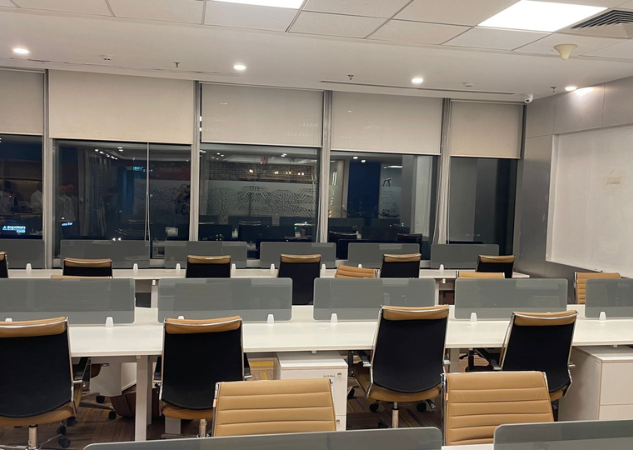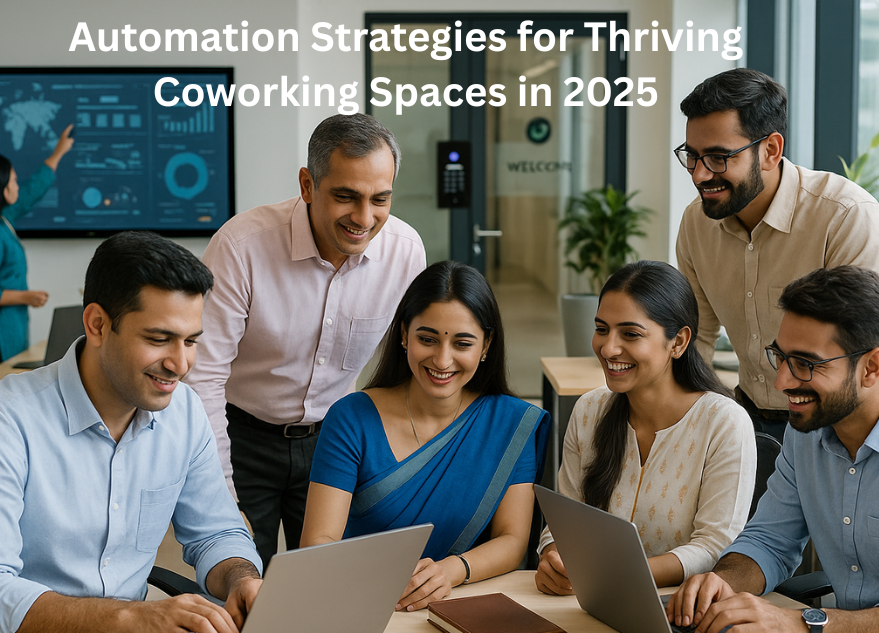Automation is key for coworking spaces to stay efficient in 2025. From smart access to automated billing, the right tools boost productivity and improve member experience. Discover how tech can streamline operations and future-proof your space.
💡 Are you looking for Coworking space in Gurgaon, Noida or Delhi? We are just a call away. Call Now: 08999 828282
10 Powerful Automation Strategies That Will Help Coworking Spaces Thrive in 2025
- Automated Check-In and Access Control Systems
- AI-Powered Workspace Allocation
- Smart Lighting and Climate Control
- Automated Billing and Invoicing Systems
- Predictive Maintenance and IoT Integration
- Virtual Receptionists and Chatbots
- Data-Driven Member Insights
- Automated Event Scheduling and Notifications
- Smart Inventory and Resource Management
- Hybrid Workspace Booking and Automation
1. Automated Check-In and Access Control Systems
Manual check-ins are outdated. In 2025, coworking spaces use automated check-in solutions like biometric scanners, QR codes, and mobile apps. These office automation tools streamline entry, boost security, and track member attendance in real time. Access control can also be role-based, ensuring only authorized members enter specific zones.
This not only improves safety but also reduces the need for front-desk staff. Integrating with workspace management software enables real-time occupancy tracking and usage analysis—making space planning easier and more data-driven.

2. AI-Powered Workspace Allocation
AI-driven systems analyze usage data and automatically allocate desks, meeting rooms, or work pods. This maximizes the efficient use of space and supports the evolving needs of members.
For example, if a team books a meeting room every Monday morning, the system can predict this pattern and reserve it in advance. Smart allocation reduces double bookings and ensures optimal resource use—supporting the future of coworking spaces.
3. Smart Lighting and Climate Control
A major part of smart offices is automated lighting and HVAC systems. These systems adjust brightness, temperature, and ventilation based on occupancy and preferences.
Sensors detect when people enter or leave a space, automatically adjusting settings for comfort and energy savings. This not only cuts operational costs but also supports eco-friendly coworking environments—appealing to sustainability-conscious professionals.
Also Read: 10 Strategies For Quickly Expanding Your Business From A Coworking Space
4. Automated Billing and Invoicing Systems
Gone are the days of manual billing. Using workspace management software, coworking spaces can automate subscriptions, usage-based pricing, and invoicing. Members receive monthly bills based on the services they use—like desk hours, printing, or refreshments.
Integrating this with accounting tools saves time, reduces errors, and improves the customer experience. Members can manage payments through self-service dashboards, making everything quick and transparent.
5. Predictive Maintenance and IoT Integration
IoT-enabled devices monitor equipment like printers, coffee machines, and AC units. These smart tools send alerts when something is about to break down, enabling preventive maintenance before it affects users.
This type of office automation extends the life of office assets and ensures smooth daily operations. Predictive maintenance reduces downtime and allows coworking spaces to function more reliably and efficiently.
6. Virtual Receptionists and Chatbots
AI-powered chatbots now handle member queries 24/7. Whether it’s booking a room, reporting a problem, or asking for Wi-Fi passwords, virtual receptionists deliver instant support.
These tools can also guide new visitors, collect feedback, and promote events. Automating these interactions reduces workload on staff and enhances member satisfaction—making your space stand out in the future of coworking spaces.
7. Data-Driven Member Insights
Smart coworking spaces use analytics to understand member behavior—what spaces they use, how often they visit, what services they prefer.
Using workspace management software, these insights can guide business decisions such as changing room layouts, launching new packages, or adjusting pricing. It also allows for personalized offers, improving member retention and satisfaction.
8. Automated Event Scheduling and Notifications
Hosting events is a core part of coworking culture. Automating the process—from invites and RSVPs to room booking and reminders—saves time and ensures smoother execution.
Integrated systems can even suggest ideal event times based on past participation data. Notifications via email, app, or SMS keep everyone informed and engaged without manual follow-ups.
💡 Are you looking for Coworking space in Gurgaon, Noida or Delhi? We are just a call away. Call Now: 08999 828282
9. Smart Inventory and Resource Management
Running out of coffee or printer paper? Automation can fix that. Sensors and inventory trackers alert managers when supplies are low and even reorder them automatically.
This ensures that daily operations run without disruption and helps cut down on unnecessary expenses. Automating resource management also reduces waste and makes your workspace more sustainable.
10. Hybrid Workspace Booking and Automation
In 2025, flexibility is key. Members want to choose between in-office, remote, or hybrid models. Workspace technology now allows seamless booking of hot desks, private rooms, or virtual meeting tools via a single platform.
It can sync with calendars, show real-time availability, and even suggest optimal times based on usage trends. This boosts utilization rates while giving members control over their workday.
Automation is not just enhancing coworking spaces—it’s redefining them. From smart access to AI-powered operations, automation helps deliver better experiences, reduce operational costs, and future-proof your business. As the future of coworking unfolds in 2025, adopting these automation strategies ensures your space doesn’t just survive—but thrives.
The Office Pass (TOP) is already leading the way with tech-enabled coworking solutions tailored for modern professionals. To learn how TOP can help you build a smarter, scalable workspace, call 08999 828282 today.
FREQUENTLY ASKED QUESTIONS (FAQS):
Question: What is automation in coworking spaces?
Answer: Automation in coworking spaces means using technology like AI, IoT, and software to streamline operations, enhance member experience, and reduce manual work.
Question: How does office automation help coworking spaces?
Answer: It improves efficiency by handling repetitive tasks like billing, room booking, and access control. This saves time and allows staff to focus on member engagement.
Question: What are smart offices?
Answer: Smart offices use connected devices and systems (like smart lighting, climate control, and sensors) to create a more responsive and efficient workspace.
Question: What is workspace management software?
Answer: This software helps coworking spaces manage memberships, bookings, billing, inventory, and analytics through a central platform.
Question: Can automation reduce costs for coworking spaces?
Answer: Yes, it cuts down on labor, improves energy use, prevents equipment failures, and optimizes space usage—all contributing to lower costs.
Question: What technologies are used in office automation?
Answer: Technologies include AI, IoT sensors, machine learning, mobile apps, and integrated platforms for management and communication.
Question: How does automation improve member experience?
Answer: It offers faster service, better personalization, easy access to services, and 24/7 support—making the experience smooth and satisfying.
Question: Is it expensive to automate a coworking space?
Answer: Initial costs exist, but automation quickly pays off by reducing expenses, increasing productivity, and improving retention.
Question: How does predictive maintenance work in coworking offices?
Answer: Sensors monitor equipment and send alerts before problems occur, allowing timely maintenance and avoiding disruptions.
Question: What is the future of coworking spaces with automation?
Answer: The future is smarter, more flexible, and member-centric. Automation enables spaces to evolve with user needs and stay competitive in a fast-changing world.



